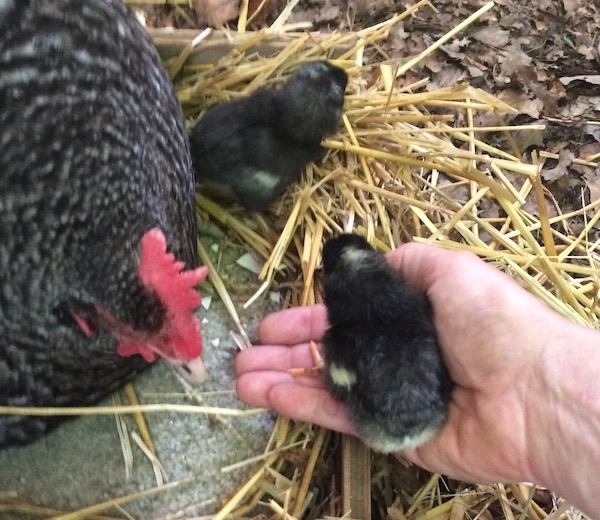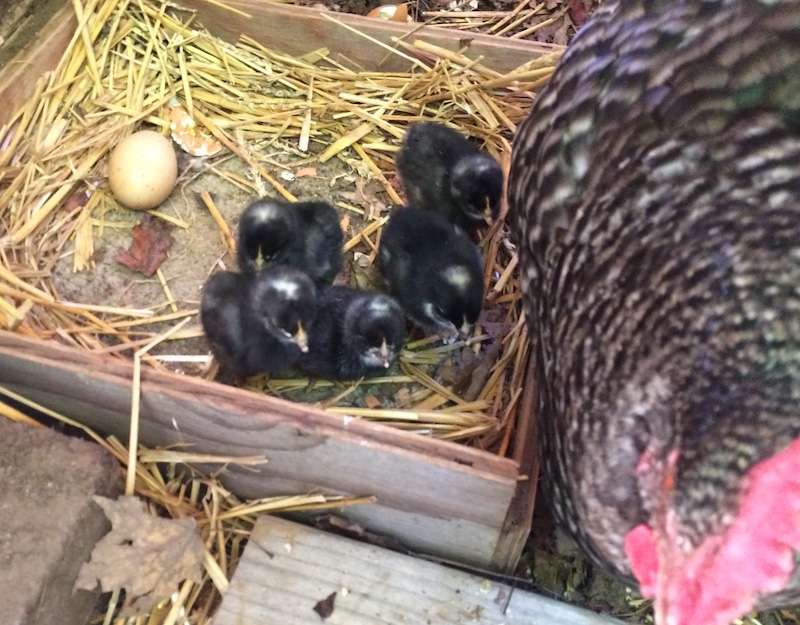
This past Tuesday Broody’s eggs started to hatch. She had two up and cheeping around. Sumo, the other broody hen, wasn’t supposed to start hatching until Friday, but she had a couple hatched on Tuesday too.
Then, I remembered that we gave Sumo a couple of Broody’s eggs. They must have been the ones that hatched — on their original timeline.
Over the next couple of days, the final results were in. Broody, with ten eggs, had only five hatch and live. She had four develop to maturity but either fail to fully hatch or died on their first day. She had one dud egg too.

Notice the size and shapes of the white spots on their heads. In theory, the irregular spots mean roosters. Simple spots mean hens. That’s the theory.
By Friday, Sumo also had five (of her six eggs) up, fluffy, and healthy. She too had one dud egg.
So, the final tally is ten chicks — five with each mama hen. Seems fair.
Both hens have been good mothers, providing shelter for their chicks to hide under and get warm. They both break up the chick starter crumble into little bits and call to their chicks with that distinctive choop-choop-choop call. Chicks come running to see what mama has for them. I was pleasantly surprised to see that Sumo has been an excellent mother. Given Lefty wanted to be a mother, I now have three hens that can go broody. Backups are always nice. 🙂

It’s too early to tell how many of the ten are hens and how many are roosters. You’re supposed to be able to tell from the size and shape of the white spots on their heads, but that’s not been too reliable in the past. Instead, I’ll just have to wait a couple weeks until they start growing in their feathers. Then, I can start to tell the light gray ones from the dark gray ones. Proof of who’s a boy and who’s a girl.
Now that all are hatched, I will be moving Sumo and her brood to a separate pen with its own predator-resistant mini-coop and hawk netting. Broody will get the full run of the half-coop for her batch.
After a few weeks, when the mamas get tired of mama-ing, I’ll know the boys from the girls and can separate them into Boy’s Cabin and Girl’s Cabins. We’ll see if my usual bad luck (getting mostly roosters) holds. My goal was to get two replacement hens for a pair that are on the retirement roster for this fall. The roosters, well, they all have reservations at Freezer Camp, as my current rooster is excellent and doesn’t need replacing.
After incubating eggs for a few years — until hens started going broody — it’s a whole lot less work letting Nature do it Her way. Both hens incubated their clutches of eggs without much effort on my part — mostly checking on them each morning to see that their food and water were okay. Now that the chicks have hatched, the mamas are keeping them warm and teaching them about food and water. I like this method much better. The only ‘trick’ is making sure I have the proper sorts of spaces for them to incubate in — away from the rest of the flock — and spaces to grow up in, protectecting the tiny birds from the really big birds (and hawks).
Now to wait and see how many roosters in this batch of ten.
